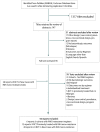Standardized treatment of active tuberculosis in patients with previous treatment and/or with mono-resistance to isoniazid: a systematic review and meta-analysis
- PMID: 20101802
- PMCID: PMC2736403
- DOI: 10.1371/journal.pmed.1000150
Standardized treatment of active tuberculosis in patients with previous treatment and/or with mono-resistance to isoniazid: a systematic review and meta-analysis
Abstract
Background: A standardized regimen recommended by the World Health Organization for retreatment of active tuberculosis (TB) is widely used, but treatment outcomes are suspected to be poor. We conducted a systematic review of published evidence of treatment of patients with a history of previous treatment or documented isoniazid mono-resistance.
Methods and Findings: PubMed, EMBASE, and the Cochrane Central database for clinical trials were searched for randomized trials in previously treated patients and/or those with with mono-resistance to isoniazid, published in English, French, or Spanish between 1965 and June 2008. The first two sources were also searched for cohort studies evaluating specifically the current retreatment regimen. In studies selected for inclusion, rifampin-containing regimens were used to treat patients with bacteriologically confirmed pulmonary TB, in whom bacteriologically confirmed failure and/or relapse had been reported. Pooled cumulative incidences and 95% CIs of treatment outcomes were computed with random effects meta-analyses and negative binomial regression. No randomized trials of the currently recommended retreatment regimen were identified. Only six cohort studies were identified, in which failure rates were 18%–44% in those with isoniazid resistance. In nine trials, using very different regimens in previously treated patients with mono-resistance to isoniazid, the combined failure and relapse rates ranged from 0% to over 75%. From pooled analysis of 33 trials in 1,907 patients with mono-resistance to isoniazid, lower failure, relapse, and acquired drug resistance rates were associated with longer duration of rifampin, use of streptomycin, daily therapy initially, and treatment with a greater number of effective drugs.
Conclusions: There are few published studies to support use of the current standardized retreatment regimen. Randomized trials of treatment of persons with isoniazid mono-resistance and/or a history of previous TB treatment are urgently needed.
Please see later in the article for the Editors' Summary
Conflict of interest statement
The authors have declared that no competing interests exist.
Figures
References
-
- World Health Organization. 2008. 108. Treatment of tuberculosis: guidelines for national programmes WHO/CDS/TB/2008 (Revised June 2008)
-
- Mak A, Thomas A, Granado M, Zaleskis R, Mouzafarova N, et al. Influence of multidrug resistance on tuberculosis treatment outcomes with standardized regimens. Am J Respir Crit Care Med. 2008;178:306–312. - PubMed
-
- Rouillon A. The mutual assistance programme of the IUATLD. Development, contribution and significance. Bull Int Union Tuberc Lung Dis. 1991;66:159. - PubMed
-
- Espinal M, Raviglione MC. From threat to reality: the real face of multidrug-resistant tuberculosis. Am J Respir Crit Care Med. 2008;178:216–217. - PubMed
-
- Espinal MA. Time to abandon the standard retreatment regimen with first-line drugs for failures of standard treatment. Int J Tuberc Lung Dis. 2003;7:607–608. - PubMed
Publication types
MeSH terms
Substances
LinkOut - more resources
Full Text Sources
Other Literature Sources
Medical
Research Materials


